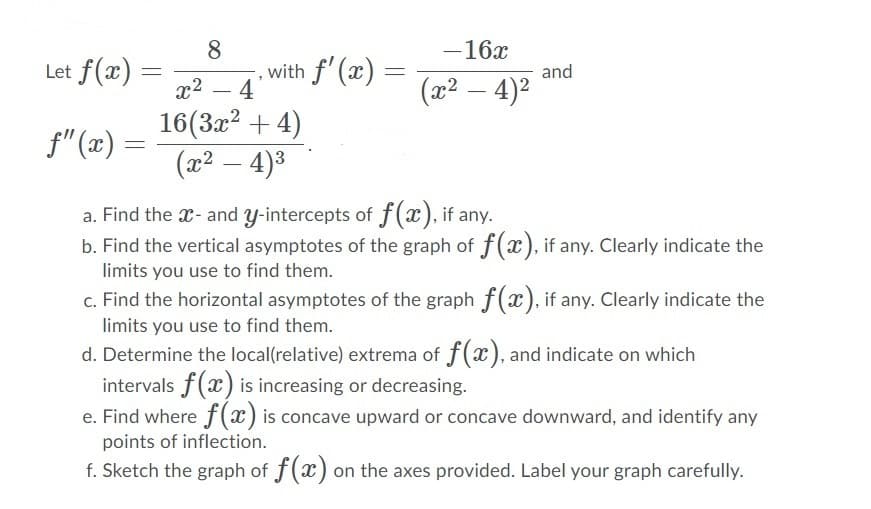8. -16x Let f(x) with f' (x) and x2 – 4 (x2 – 4)2 - 16(3x? + 4) (x² – 4)3 f"(x) = | a. Find the x- and y-intercepts of f(x), if any. b. Find the vertical asymptotes of the graph of f(x), if any. Clearly indicate the limits you use to find them. c. Find the horizontal asymptotes of the graph f(x), if any. Clearly indicate the limits you use to find them. d. Determine the local(relative) extrema of f(x), and indicate on which intervals f(x) is increasing or decreasing. e. Find where f(x) is concave upward or concave downward, and identify any points of inflection. f. Sketch the graph of f(x) on the axes provided. Label your graph carefully.
8. -16x Let f(x) with f' (x) and x2 – 4 (x2 – 4)2 - 16(3x? + 4) (x² – 4)3 f"(x) = | a. Find the x- and y-intercepts of f(x), if any. b. Find the vertical asymptotes of the graph of f(x), if any. Clearly indicate the limits you use to find them. c. Find the horizontal asymptotes of the graph f(x), if any. Clearly indicate the limits you use to find them. d. Determine the local(relative) extrema of f(x), and indicate on which intervals f(x) is increasing or decreasing. e. Find where f(x) is concave upward or concave downward, and identify any points of inflection. f. Sketch the graph of f(x) on the axes provided. Label your graph carefully.
College Algebra
7th Edition
ISBN:9781305115545
Author:James Stewart, Lothar Redlin, Saleem Watson
Publisher:James Stewart, Lothar Redlin, Saleem Watson
Chapter3: Polynomial And Rational Functions
Section3.6: Rational Functions
Problem 2E
Related questions
Question
can you please do the last 3

Transcribed Image Text:8.
-16x
Let f(x)
with f' (x)
and
x2 – 4
(x2 – 4)2
16(3x? + 4)
(x² – 4)³
f"(x) =
a. Find the x- and y-intercepts of f(x), if any.
b. Find the vertical asymptotes of the graph of f(x), if any. Clearly indicate the
limits you use to find them.
c. Find the horizontal asymptotes of the graph f(x), if any. Clearly indicate the
limits you use to find them.
d. Determine the local(relative) extrema of f(x), and indicate on which
intervals f(x) is increasing or decreasing.
e. Find where f(x) is concave upward or concave downward, and identify any
points of inflection.
f. Sketch the graph of f(x) on the axes provided. Label your graph carefully.
Expert Solution
This question has been solved!
Explore an expertly crafted, step-by-step solution for a thorough understanding of key concepts.
Step by step
Solved in 2 steps with 2 images

Knowledge Booster
Learn more about
Need a deep-dive on the concept behind this application? Look no further. Learn more about this topic, calculus and related others by exploring similar questions and additional content below.Recommended textbooks for you

College Algebra
Algebra
ISBN:
9781305115545
Author:
James Stewart, Lothar Redlin, Saleem Watson
Publisher:
Cengage Learning

College Algebra
Algebra
ISBN:
9781305115545
Author:
James Stewart, Lothar Redlin, Saleem Watson
Publisher:
Cengage Learning